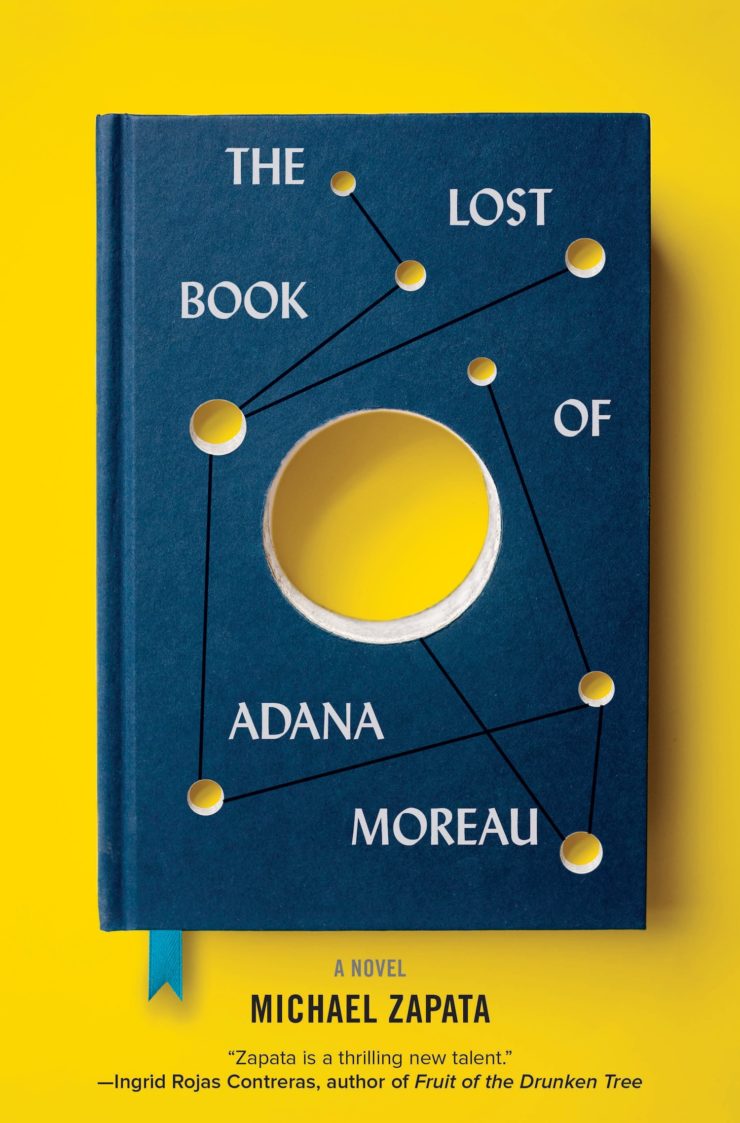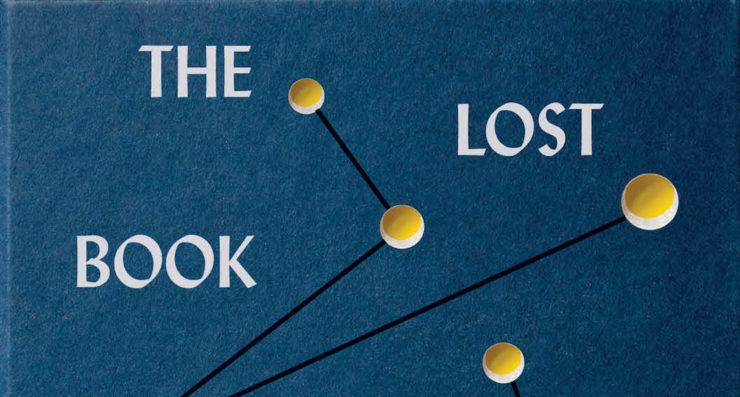We’re excited to share the cover for Michael Zapata‘s The Lost Book of Adana Moreau, the story of a Latin American science fiction writer and the lives her lost manuscript unites decades later in post-Katrina New Orleans. Check out the full cover below and preview an excerpt from the novel—publishing February 2020 with Hannover Square Press.
In 1929 in New Orleans, a Dominican immigrant named Adana Moreau writes a science fiction novel titled Lost City. It is a strange and beautiful novel, set in a near future where a sixteen-year-old Dominican girl, not all that unlike Adana herself, searches for a golden eternal city believed to exist somewhere on a parallel Earth. Lost City earns a modest but enthusiastic readership, and Adana begins a sequel. Then she falls gravely ill. Just before she dies, she and her son, Maxwell, destroy the only copy of the manuscript.
Decades later in Chicago, Saul Drower is cleaning out his dead grandfather’s home when he discovers a mysterious package containing a manuscript titled A Model Earth, written by none other than Adana Moreau.
Who was Adana Moreau? How did Saul’s grandfather, a Jewish immigrant born on a steamship to parents fleeing the aftershocks of the Russian Revolution, come across this unpublished, lost manuscript? Where is Adana Moreau’s mysterious son, Maxwell, a theoretical physicist, and why did Saul’s grandfather send him the manuscript as his final act in life? With the help of his friend Javier, Saul tracks down an address for Maxwell in New Orleans, which is caught at that moment in the grip of Hurricane Katrina. Unable to reach Maxwell, Saul and Javier head south through the heartland of America toward that storm-ravaged city in search of answers.
The Lost Book of Adana Moreau publishes February 4, 2020 with Hanover Square Press.
Buy the Book


The Lost Book of Adana Moreau

His father was a pirate. He had black skin and was a pirate. Regardless of his occupation, or maybe because of it, he was charming and warm-hearted and loved listening to most anybody who had a story to tell. His mother was a servant to an old Spanish, sugar plantation family just outside of San Pedro de Macorís. It was said she had Taíno blood in her veins and never lied. She had long, coffee colored hair and all she had known her entire life was the plantation house where she worked with her mother, the seas of the Antilles, and her parents.
On May 16th 1916 the American Marines landed on the island and her mother and father were killed shortly after in the ensuing guerilla war waged by the peasant gavilleros against the Marines, who, according to her father, were nothing more than tígueritos hired by greedy American businessmen who wanted to force them off their land to expand the sugar plantations. The night before her parents’ deaths, she had been half-asleep watching an ashy-faced owl perched outside her bedroom window when she heard her parents in the kitchen. She got out of bed. It was nearly midnight.
“We should leave now,” her mother said.
Her father put his finger to his lips and her mother nodded.
“In the morning,” her father whispered.
Her mother and father stood in the kitchen and held each other and she noticed there was blood on her father’s pants. She understood then that her father and mother were gavilleros. When her mother spotted her over her father’s shoulders, she smiled and went to her. Her mother stroked her long, coffee colored hair, just as she had done when she was a child, and told her that the world was the same as it ever was and not to worry. First thing in the morning, the American Marines came to their home. She hid under their little village house where there were small pools of water and dirt and sand and dirty-ashen seashells. Once-in-a-century, her father had told her, the sea flooded the land and for a time neither existed.
Two days later her family’s employers decided to leave for New York City or back to Madrid, she couldn’t remember, but the important thing is they fled to a city that wealthy people have been fleeing to for centuries. The last thing they told her before speeding off in a taxi was that the Antilles were brutal and she was one of the last of a brutal race. She thought of her mother, who had worked for the Spanish family since she had been nine. She was sixteen. She didn’t want to go home, so she lived alone in the plantation house for two months, wandering from room to room, eating what was left in the kitchen, cleaning as she had done before, and sleeping for days at a time on a bed that had once belonged to a queen from the House of Bourbon.
One afternoon, she packed her clothes and left the plantation house. She headed west, towards Santo Domingo, sometimes walking for long stretches at a time along the coast which was dotted with estates and villages without names (or rather names she had never known) and sometimes riding in the back of a cart driven by a sugar worker who understood without saying so that she was the daughter of murdered gavilleros. For five weeks she wandered the streets of Santo Domingo, which were like the streets of a labyrinth, and ate fish and bread scraps at the market. At night, she slept on park benches and dreamed of future civilizations and an endless seabed full of strange luminescent creatures.
At the end of five weeks, she met an American in the market who said he was trading with the gavilleros and the American Marines. She didn’t know why, but she told him the story of how the American Marines had killed her parents. He listened without saying a word. When
she was done, he said that he was really a pirate. He said that he gave the gavilleros a deep discount and sold shoddy equipment to the American Marines at high prices. He was making money hand over fist. He apologized for talking so much and then he said she was beautiful. He said he had never seen a more beautiful woman in the Caribbean than her. She told him that his Spanish was good, if a little outdated. He said that he also spoke French and some Arabic. The pirate studied her face for a moment and then said he could get her on a ship that would take her to New Orleans. She shook her head.
“Why not?” asked the pirate.
“Americans are greedy tígueritos,” she said, “they’re shit.”
“And me?”
“I don’t know yet. Maybe you’re shit. Maybe you’re not shit.”
Still, she thought about her prospects on that occupied island and decided to leave Santo Domingo. On the ship voyage she met a boy who looked out of place. He had deep, sky black eyes. When she asked the boy where he was from, he said he was from nowhere.
“So, you’re an orphan,” she said.
“An orphan,” he said and smiled politely.
“Like me,” she said.
Like everybody, she thought. Orphans are all the world really has left.
For six days, she lived on the deck of the ship and slept near the orphan boy. She listened as he talked about war and mechanical soldiers and an eternal library that he would one day discover and never leave. He’s mad, thought the servant girl. He spoke Spanish well enough, but sometimes he sang in a language that she didn’t understand. The songs were like a melismatic trance. One morning, in the middle of a song, he stopped singing and told her that the ship was entering the eye of the Gulf of Mexico.
“How do you know where the eye is?” she asked the boy, teasing him. “Just look,” he said and shrugged.
The sea was deep blue and alien and as vast as the sky. She imagined that in the distant future the end of the world would have its origins there and for some unknown reason this put her at ease. When the ship arrived in New Orleans, the pirate was waiting for her. A few days later, he asked for her hand in marriage and she said yes.
On April 7th, 1920 Maxwell Moreau was born in a one-room apartment near the Barracks Street Wharf. His mother labored for seventeen hours and during painful bursts of activity she squeezed her eyes shut and tried to focus on the smells of coffee and bananas and boiled crawfish and the blows and whistles of far-away ocean liners. This was something, she thought, that all mothers giving birth in New Orleans probably did. When Maxwell Moreau finally came out, the pirate knew that his son would not be a pirate like him, spending his life on the surface of the sea, a loud and violent sea that swelled with creatures and myths and drove men to early deaths, or worse, to an asylum. He swore to it and told his wife that their son had ochre eyes, which were the pigment of earth.
The baby Maxwell Moreau cried and cried and his mother held him to her breast and whispered son et lumière, which was something her husband had taught her to say in French and which meant sound and light and was everything the earth wasn’t.
The Dominicana and the pirate soon bought a home on Melpomene Avenue. Occasionally, the pirate worked for a wealthy Creole smuggler, often for long periods of time at sea or by river and then by marsh in order to help him hide jugs of Cuban rum in the trunks of cypress trees or guard him as he tried to strike deals with Isleños, laughing or rather pretending to laugh, which was a type of threat, at least according to the pirate who listened to most anybody with a story to tell, especially an inscrutable Isleño. He might as well have pistols for ears and a shotgun for a tongue, he might as well start a gang war, the pirate once told his wife, but he still went and worked for the wealthy Creole smuggler and she still saw him off and waved as he boarded a motorboat. Sometimes, when the wealthy Creole smuggler turned his back to the pirate, he saluted him in mockery of the United States Navy. Then, more often than not, the Dominicana stood and chatted with the wealthy Creole smuggler’s wife in the lilting heat and saunter of the Louisiana sun and watched the trill of fishing boats and egrets drift over the Mississippi River as if they were comets lost in the creation of things.
At three, Maxwell Moreau began to wander. He liked sound and light and he followed it everywhere like how the ancient Hebrews followed celestial clues and iconographic fever-dreams in the desert. One day a hornet entered the house on Melpomene Avenue and stung Maxwell. He didn’t cry. In fact, when the hornet flew out the back door and into a garden of sunflowers Maxwell followed it. The hornet flew into another yard and then another before finally landing on a tree. A dog with a half-black muzzle was chained up to the tree and when it saw Maxwell it began to bark. Maxwell thought that the dog was even more interesting than the hornet. He walked over to the dog, but stopped just short of the length of the chain. The dog barked and barked and Maxwell smiled and smiled. He teased the dog and because Maxwell was canny like Sisyphus he eventually figured out how to untie the dog without the dog biting him. The dog disappeared for some time and Maxwell waited. Just before dusk, the dog returned and lay down near the tree. Then Maxwell lay down near the dog with his body pressed against the earth, a pulsating earth with heart beats, which were the dog’s heart beats, and tremors, which were the tremors of the City, and murmurs, which were subterranean rivers slipping into the lower Mississippi. He then slept in complete peace, and this is how his mother found him.
Ages ago, she thought as she picked up her sleeping son and held him close, as close as she ever had, the world must have been covered with abandoned or lost children lying on the earth. She then imagined in horror that a prehistoric bird must have fed on these children. Even though she knew that those kinds of birds must be extinct, she still imagined that one had been circling vulture-like for her child and that she had arrived just in time. She had no idea where this absurd fear came from and when she returned home with her child she immediately told her husband, who had just come home from a three-week venture. He said that her fears were reasonable. He said that there must have been a time when immense and terrible birds fed on children. He said that there might even be a few of the monsters left somewhere in the world, maybe in India or South America.
As Maxwell’s tendency to wander increased, his parents grew more and more worried and they decided to frighten him. They went to the library together and since only the pirate could read he found a book called Dinosaurs and Birds of the Cretaceous and Jurassic Eras. Maxwell sat on his mother’s lap while his father read out-loud to him and showed him illustrations of Pteranodons and Pterodactyls and Pterosaurs. In hushed tones they told their son that when he wandered monstrous creatures with sword-like beaks and black wings took to the sky and searched for him. If they found him, they would devour him. When they told Maxwell this, his eyes lit up and he squirmed and laughed and his parents realized that they had made a terrible mistake.
Yet, one thing did seem to work. Maxwell’s mother noticed that when Maxwell had a book directly in front of him he was less prone to wandering. She took him back to the library. At the library, she met a librarian named Afrah or Afraa or Annan, depending on who was speaking to her. For example, visitors to the library or city officials called her Annan, but family members and friends – of whom she had many – called her Afraa. Her husband was the only person who called her Afrah, which was really the same as Afraa, but her husband pronounced the ‘ah’ with a lilt that could only be described as the lilt of someone who was deeply in love. She was half Persian and half Haitian and she made it a point to tell the Dominicana that she lived in the Marigny, which in the 19th century was full of Haitian refugees and which was now full of mixed families, musicians, and writers.
Afraa spoke of Haiti in the same way other people spoke of violent love affairs. More than a few times she said that St. Peter would never let her through the gates of heaven on account that she would be incredibly bored there. Heaven would be like a very boring Port-au-Prince, she would say, one without the madness of survival, one without the sea, one without women like her mama whose curves swelled with the seasons. The Dominicana and Afraa quickly became close friends. She called Maxwell a little island mestizo and she called his mother the kindest Dominicana she had ever met, which was the truth.
At first, Afraa gave the Dominicana spoken English lessons at the library each Wednesday and Friday afternoon. Later, in addition to the library lessons, Afraa would visit the Dominicana each Monday night at her home on Melpomene Avenue. They would eat red beans and rice and then Afraa would read out loud for the Dominicana and her son. Translated into Spanish, she read Persian poetry, Assyrian myths, Greek myths, and African myths. She read the fables of José Núñez de Cáceres, the Dominican revolutionary. She read Latin American pastorals, modernismo poetry, and indigenismo novels, which, the librarian said, were all simulacrums of Don Quixote. That book, she explained with a smile, was the one from which all others were endlessly replicated. So, of course, she also joyfully read Don Quixote for the Dominicana and her son. Translated into English, she read a slim Russian novel titled We by Yevgeny Zamyatin. She read British plays and American short stories. She read the horrifying and elegant works of Edgar Allen Poe. She also read The Adventures of Huckleberry Finn and Moby Dick, which, the librarian suggested, would help the Dominicana make sense out of the American character. The American character, the librarian theorized, was obsessed with movement and tyranny, like a madman, and different from the European character, which was obsessed with systems and order, like a lieutenant, and also very different from the Latin American character, which was obsessed with the abyss of time, Aztec labyrinths, and the Minotaur who wandered both. The Madman, the Lieutenant, and the Minotaur, the librarian said, constituted the entire history of the New World. In time, by listening to each word and following along with her smiling eyes, the Dominicana learned how to read.
Copyright © 2020 by Michael Zapata, from The Lost Book of Adana Moreau. Reprinted by permission of Hanover Square Press.










